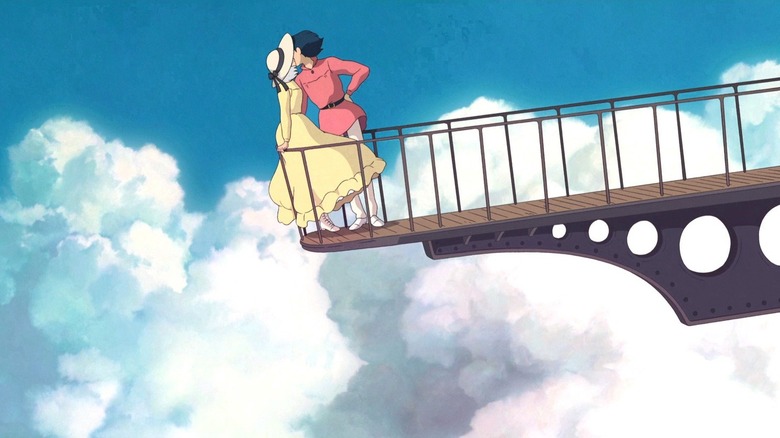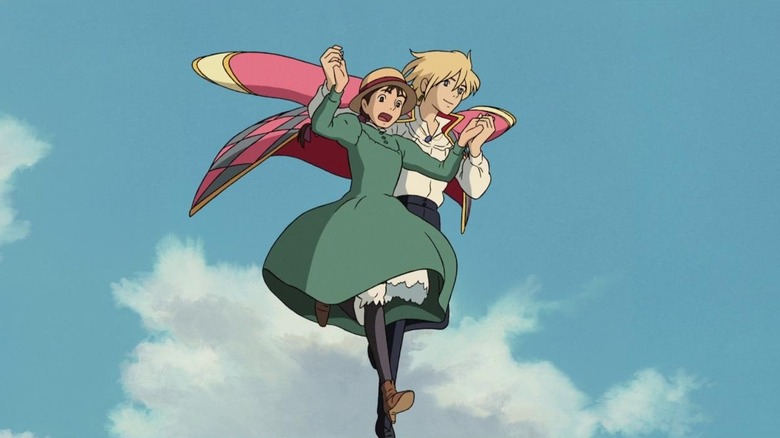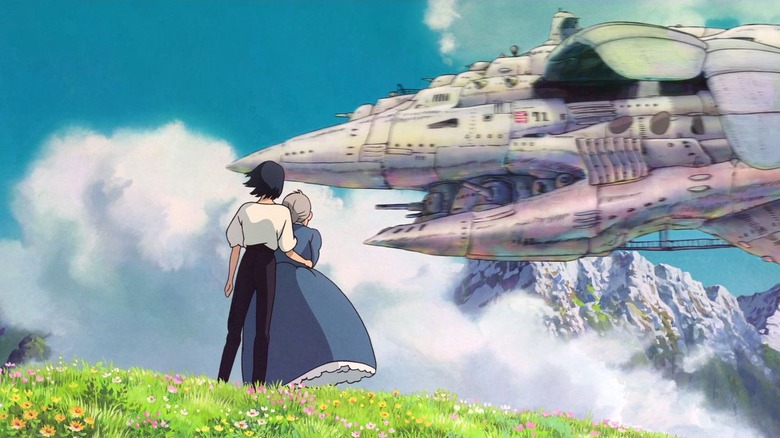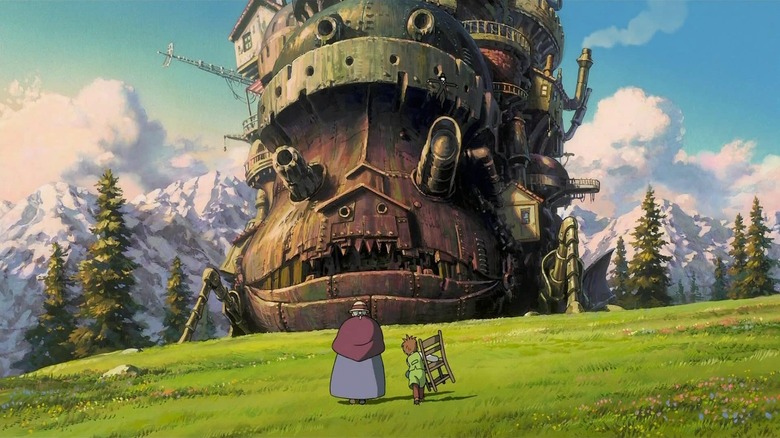The Ending Of Howl's Moving Castle Explained
By the time "Howl's Moving Castle" was released in 2004, director Hayao Miyazaki was an Oscar-winning filmmaker, notable for animated films such as "Spirited Away," "My Neighbor Totoro," and "Princess Mononoke." Miyazaki's films are packed with directorial trademarks and are highly regarded for their visual beauty and exquisite art style. But as the years have passed, they have become even more well-known for their deeper themes about humanity and its various shortcomings. "Howl's Moving Castle," Miyazaki's ninth feature, was no exception to this.
Based on Diana Wynne Jones' 1986 novel, "Howl's Moving Castle" focuses on Sophie Hatter, a young hat maker who is cursed by an evil witch and transformed into an old woman. Sophie seeks out the help of the mysterious wizard, Howl, who resides in a moving castle where Sophie eventually takes a job cleaning and taking care of Howl and his companions. Miyazaki's film diverges greatly from its source material to deliver an ending that is romantic, yet critical of militarization, 21st century imperialism, and technological innovation.
Although the film's ending features many spectacular elements — from war machines to monstrous transformations — many viewers might miss what is lying beneath the surface of this unforgettable film. Here's everything you need to know about the ending of "Howl's Moving Castle."
What you need to remember about the plot of Howl's Moving Castle
Like many of Hayao Miyazaki's films, there are a lot of characters and intertwining narratives in "Howl's Moving Castle" that might be difficult for viewers to keep track of. For the most part, the audience follows Sophie, who lives a peaceful yet mundane life in the kingdom of Ingary, who war with the neighboring kingdom of Strangia over the disappearance of their prince. After a brief encounter with the wizard Howl, Sophie is visited at her shop by the Witch of the Waste, who curses Sophie to appear older in age out of jealousy for Howl's attention towards her.
In search of a cure for the curse, Sophie travels to the titular wizard's abode. There, she hires herself as a cleaning lady as part of a deal with the fire demon Calcifer, who powers Howl's castle with his magic. Meanwhile, Howl ignores pleas from the kingdom of Ingary to aid the war efforts, despite his disappearing at night to transform into a bird form and intervene with both sides in the hopes it will bring peace.
During Sophie's visit to Ingary to refuse the call on Howl's behalf, the king's sorceress Madame Suliman drains the Witch of the Waste of her powers and threatens to do the same to Howl if he doesn't fight for the king. Howl rescues Sophie and the Witch, while Sophie's town is attacked by Suliman's henchmen searching for Howl.
What happened at the end of Howl's Moving Castle?
Although Sophie begs Howl not to go back into the war, Howl has found the courage to fight, now that he has Sophie to protect. While trying to rescue everybody else, Sophie accidentally douses Calcifer trying to remove him from his hearth, causing the castle to collapse as Sophie falls down a chasm. She awakens in the past, encountering a young Howl and Calcifer, before she's returned to the present and finds Howl.
With the help of the Witch of the Waste — who recovered Howl's heart from Calcifer's flame — Sophie revives Howl, who awakens and remarks that his chest feels heavy. Sophie retorts, "A heart's a heavy burden," before professing her love for Howl. Even though Sophie has been freed from her curse, having returned to her younger form, she decides to stay with Howl. Calcifer, who has also been freed from his link with Howl, also decides to stay, having begrudgingly learned to care for the wizard over their time together.
Meanwhile, the war between Ingary and Strangia ends when the prince of Strangia is recovered and decides to return to cease fighting, as Suliman also watches the events and pulls back her troops in retreat. In the film's final shot, Sophie and Howl share a kiss atop the moving castle as it heads off in a new direction, away from the ongoing warfare.
Every character undergoes a transformation
It's no surprise that change is a major theme of "Howl's Moving Castle," and several of the characters make severe physical transformations over the course of the film — from Sophie's curse that turns her into an old woman to Howl's magic transforming him into a bird creature to fight in the war. However, these are metaphors for the emotional transformations occurring inside each of these characters. As film analyst Adam Dobay described it, it's the opposite of a coming-of-age film, featuring characters who "are actively trying to avoid adulthood for most of the runtime."
For instance, Sophie's old age is something she quickly has to embrace, making her a more confident and assured person in her interactions with others. Meanwhile, Howl's cowardice and immaturity — pertaining to both his role in the war and the color of his hair – is a comfort zone he's more eager to break out of the more he falls in love with Sophie. Even the Witch of the Waste — whose insecurity and vanity prompt her to curse Sophie at the beginning of the film — is humbled when her powers are stripped from her, making her helpless and sympathetic.
Even though Sophie eventually returns to her younger age by the end of the movie, she still retains her grey hair from the curse. This is the true mark of change in Sophie, and her experiences as an older woman have permanently altered her both emotionally and physically.
The truth behind Calcifer's connection to Howl
For most of "Howl's Moving Castle," Calcifer plays the role of comedic relief — particularly in the English dub where he's voiced by American comedian Billy Crystal. However, by the end of the film, viewers might have come to the realization that Calcifer is the emotional crux of the film; as John Lasseter describes it in the "Behind the Microphone" DVD extra, "Only Billy could take fire and give it heart."
Calcifer's connection to Howl originated during the wizard's adolescence. The fire demon arrived on Earth as a falling star, and Howl saved him by giving him his heart. Once Sophie realizes that Howl's heart and Calcifer are one and the same, it explains a lot about how important their connection is throughout the film. Earlier, Howl even calls Calcifer "his weakest point," alluding to Howl's overall journey of needing to find love to force him out of his immaturity and into responsibility.
Even after getting on each other's nerves the whole movie, the bond between Howl and Calcifer is incredibly strong, and it's not just because of the magic. By the end of the film, Calcifer's decision to stay with Howl isn't because of a contract between them, but out of genuine care for his longtime friend.
Turnip Head's identity is revealed
One of the most iconic characters from "Howl's Moving Castle" is Turnip Head, a living scarecrow who helps guide an older Sophie to Howl's castle. Given the similarities between "Howl's Moving Castle" and "The Wizard of Oz," it would be easy to compare Turnip Head to the scarecrow in L. Frank Baum's 1900 novel. However, that scarecrow's transformation from brainless to intelligent is replaced here with regaining consciousness, as Turnip Head returns to his original form at the end of the film.
After Sophie plants a kiss on Turnip Head's cheek, the scarecrow surprisingly transforms into Prince Justin, the missing prince from Strangia whose disappearance sparked the war that plagues both kingdoms. This plays into the film's overall themes of the pointlessness of war, given that Strangia had assumed that Prince Justin had been abducted by the kingdom of Ingary. In actuality, he had simply been cursed into becoming a voiceless scarecrow who could only express his love for Sophie through his actions.
Turnip Head's transformation also embodies the idea of loyalty, given that he's unfailingly protective of Sophie throughout the film. Although Sophie's heart lies with Howl, Prince Justin gracefully accepts this loss and vows to return after putting an end to the war. It's a storybook ending for a character who seems straight out of a traditional fairy tale.
How Howl's Moving Castle differs from its source material
For the most part, Hayao Miyazaki's version of "Howl's Moving Castle" stays faithful to many aspects of Diana Wynne Jones's original fantasy novel. Although the book contains many narrative threads that were dropped from the movie, Miyazaki had a lot of elements he wanted to add to the original story to enrich it and make it more personal for him. A big one was the addition of the war between Ingary and Strangia as a major set-piece throughout the film, even though it's only briefly mentioned in the book.
Another major change Miyazaki made between the book and film was making the Witch of the Waste a more sympathetic character, draining her of her powers during the film's midpoint. In the original book, the Witch of the Waste is the main antagonist, whose goal is to create the perfect human by assembling parts of other wizards and needing Howl for the head.
The character arc of Howl is also entirely different in the movie. In Jones' novel, Howl is a womanizer whose ways are changed when he meets Sophie. In the film, however, Howl's appearance may be flamboyant but it is something he uses as a mask to hide his own cowardice. While many of these changes were necessary when translating prose to animation, lots of them give the film an identity that fits in well with the rest of Miyazaki's filmography.
Some critics felt the film's second half was lackluster
As Hayao Miyazaki's follow-up to his critically-acclaimed masterpiece "Spirited Away," expectations were high for "Howl's Moving Castle," and for the most part, reviewers felt satisfied. Upon its release in the United States in 2005, The New York Times heralded the film as "wildly imaginative, emotionally intense and surpassingly gentle," while other publications praised its beautiful art style, thematic resonance, and fantasy worldbuilding. These reviews, more or less, were par for the course when it came to Miyazaki's consistent and careful work.
For some reviewers, the second half of the film — especially the ending — wasn't as enchanting as the film's visuals would have you believe. In a less-than-generous review from The Washington Post, reviewer Stephen Hunter criticized its plot, writing, "When it finishes, you wonder why it went where it went, if it can even be said to have gone there."
However, some reviews from this time indicate that the critics didn't fully understand Miyazaki's intent behind the film. In a criticism from Variety that complained about its second half being too long and narratively incoherent, they wrote, "What's missing perhaps, is a more driving sense of Sophie's quest to regain her youth." This interpretation of the film's meaning, while understandable given Sophie's transformation back into a young woman at the end of the film, misses the point of her having changed and accepted adulthood through her experiences with Howl.
The soundtrack reveals a secret to the film's timeline
Although Hayao Miyazaki's films are mostly beloved for their visual beauty, they also have some of the best film scores of all time. For "Howl's Moving Castle," the score was composed by Joe Hisaishi, who has worked with Miyazaki on every single one of his films except for "The Castle of Cagliostro." For "Howl's Moving Castle," Hisaishi made use of leitmotifs — short musical phrases assigned to various characters or moments throughout the film.
One of the musical pieces that appears throughout the film chronicles the love story between Howl and Sophie, and is titled "Merry-Go-Round of Life." The instrumental song's title has also given credibility to one interpretation of the film's ending as causing a time loop. When Sophie mysteriously ends up traveling back in time and encountering a young Howl, she tells him and Calcifer to find her in the future before she's whisked away back to her present.
If viewers go back and re-watch Sophie's first encounter with adult Howl in the film, Howl tells her he's been looking all over for her. In a way, this time paradox of Sophie's creation was a necessary occurrence for Howl to regain his heart, making their love story a true merry-go-round of life.
What Hayao Miyazaki has said about the film's ending
Perhaps the most significant of Hayao Miyazaki's many changes to "Howl's Moving Castle," is the inclusion of the war between the kingdoms of Ingary and Strangia, something that plagues Sophie's hometown and inevitably draws Howl into the conflict. The centrality of this plot point was very deliberate for Miyazaki, given the film's release only a year after the American invasion of Iraq in 2003. The director expressed his discontent for the war by choosing not to be present at the Academy Awards the year "Spirited Away" won Best Animated Feature.
As "Howl's Moving Castle" developed into a movie with strong themes of anti-war and pacifism, Miyazaki was convinced the film wouldn't be received well by a Western audience. This is especially present in the film's final scene, where Howl's castle heads off in a direction away from flying warcraft, signifying that while the central characters are escaping to peace, the threat of war will continue to linger over the kingdoms.
However, Miyazaki has confirmed that — compared to some of his other films — his intent behind "Howl's Moving Castle" was to create a film that was more optimistic about the world. In one interview, Miyazaki stated, "The reason that we made "Howl's Moving Castle" is that there are too many unhappy matters in the world, such as wars and economic crises. We hope that, through the movie, people can keep up their courage and see the hope."
The themes of Howl's Moving Castle are present in Hayao Miyazaki's other films
You don't have to see Hayao Miyazaki's entire filmography to know the director has a soft spot for the beauty of flight. Thematically, flight appears in most of his films, particularly in "Porco Rosso" and "The Wind Rises," and there are also iconic flying scenes in films like "My Neighbor Totoro" and "Kiki's Delivery Service." "Howl's Moving Castle" is no exception, as the film depicts flying machines and aircraft, as well as Howl's monstrous bird form.
From Miyazaki's perspective, flight has two separate meanings. As SlashFilm put it, Miyazaki's view is "that the power and magic of aviation and flight is both to be treasured and feared." Flying through the sky in Miyazaki's films, or even walking through it as depicted in "Howl's Moving Castle," is a source of freedom. Despite the film's other themes of modernity and militarization, the way it views flight is more positive than some of his other works.
And yet, Miyazaki's philosophy on flight may be the key to his wider philosophy of filmmaking, especially when it comes to projects like "Howl's Moving Castle." In an interview with Animerica in 1997, Miyazaki was quoted as saying, "At one time, flight, too, was something that just took place only in the world of imagination." In a sense, the dichotomy between the reality of flight as a weapon versus the dream of soaring freely through the sky is inspiring for Miyazaki.
Static Media owns and operates SlashFilm and Looper
Why it is Hayao Miyazaki's favorite of his films
In 2013, Hayao Miyazaki attended the Venice Film Festival to screen "The Wind Rises," which was originally set to be his final film before he came out of retirement (again) for "The Boy and the Heron" in 2023. There, when asked which of his films is his favorite, Miyazaki answered, "Howl's Moving Castle," noting "I wanted to convey the message that life is worth living, and I don't think that's changed" (Cavallaro 2015).
For those familiar with Miyazaki's work, it's easy to draw conclusions as to why the director says that "Howl's Moving Castle" is a personal favorite. In an article from The Spool, they compared the film to the titular fortress, writing, "Like Howl's castle, this movie is cobbled together from mismatched parts; it looks unstable and threatens to tumble over as it rambles along, but master wizardry holds it together." It combines loads of Miyazaki's influences, from his political rage to his visual affection for European aesthetics, into one gloriously beautiful film about true love.
"Howl's Moving Castle" was made in Miyazaki's fourth decade as a filmmaker, so it's easy to see why the director felt compelled to make a film about how even those who have aged a long time, whether by a curse or by time, still have a lot of growing up to do. When Sophie tells Howl, "A heart's a heavy burden," audiences can hear the wisdom of a filmmaker who's learned how to appreciate the simplicity of life.











